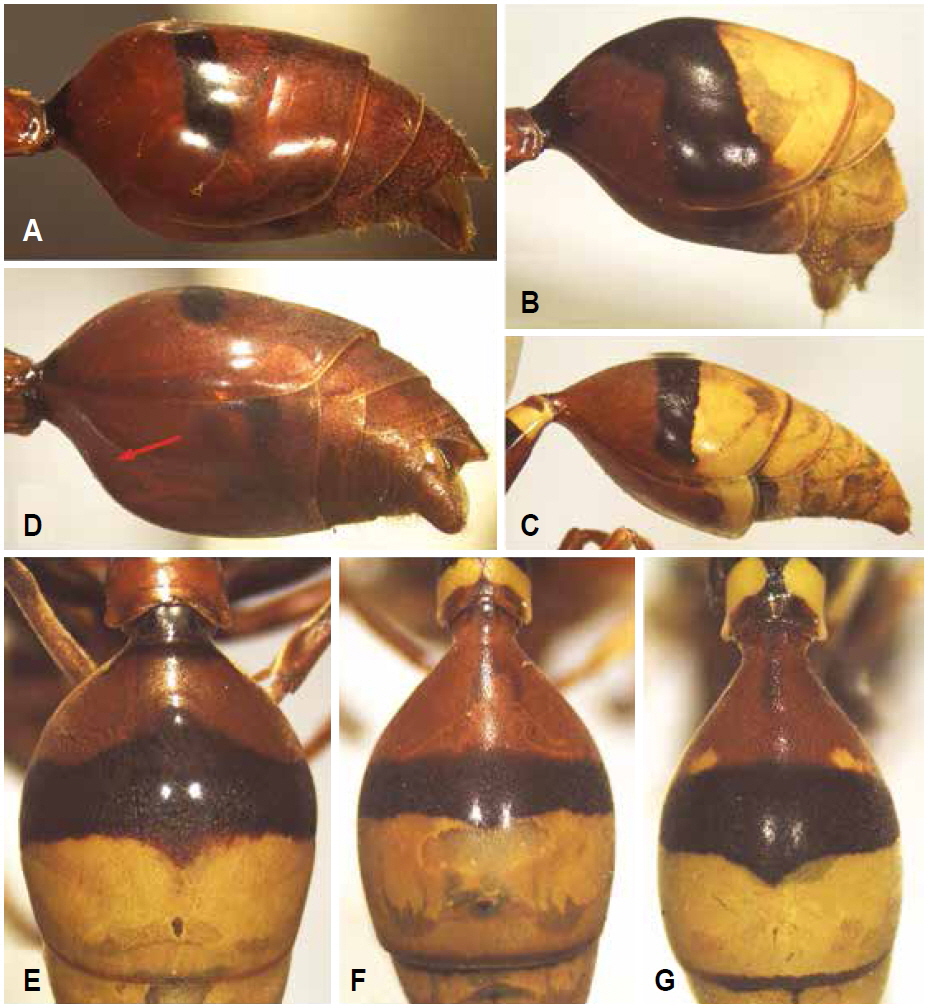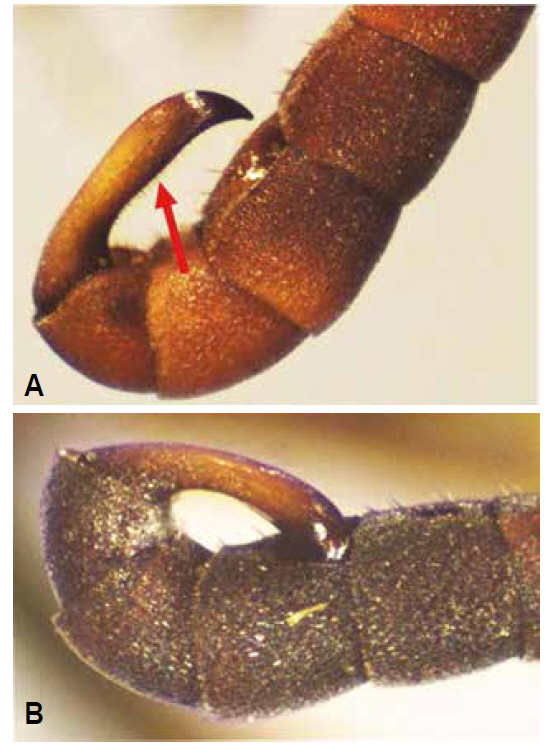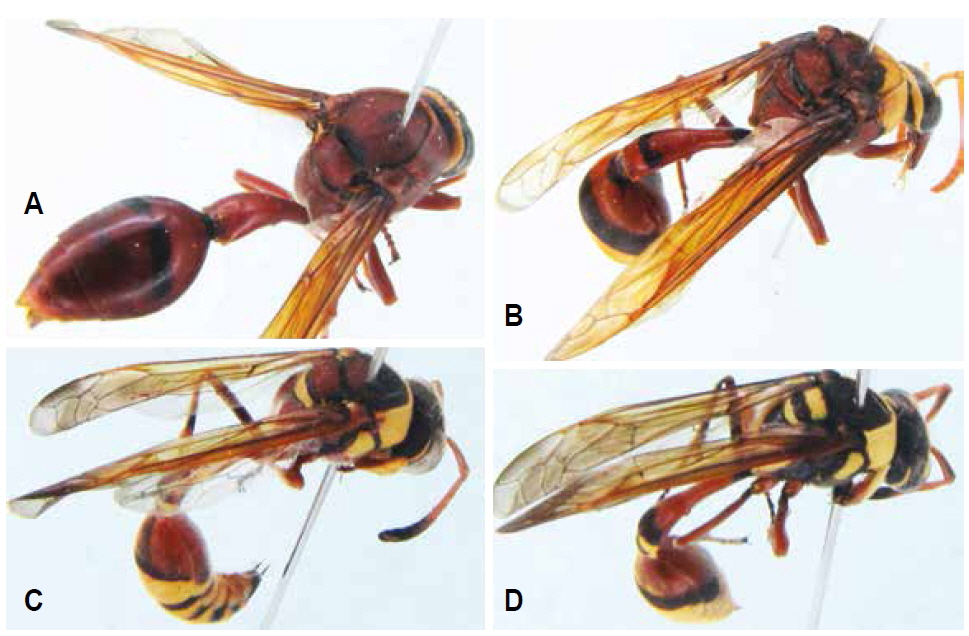



A taxonomic study of the genus Delta de Saussure, 1855 from Vietnam is presented. A total of four species are recorded: D. campaniforme campaniforme (
The genus
Three species of the genus were recorded in Vietnam before, namely
The materials examined in the present study are those deposited in the collections of the Institute of Ecology and Biological Resources (IEBR), Hanoi, Vietnam. Observations of morphological and color characters were made on the pinned and dried specimens under a stereoscopic dissecting microscope.
Photographic images were made with the Leica EZ4HD 3.0 MegaPixel Digital Stereo Microscope, using LAS exclusive microscopy software (LAS EZ 2.0.0); the plates were finished with Photoshop CS6, mostly to adjust the size and background.
Morphological terminology follows Yamane (1990).
Order Hymenoptera
Family Vespidae
Subfamily Eumeninae
Genus
Type species:
Diagnosis. Diagnosis for the genus
The present key to species of the genus
1. Metasomal tergum 2 in lateral view strongly swollen dorsally in one-third, then gradually convex to apical margin of the tergum, metasomal sternum 2 in lateral view strongly swollen ventrally in anterior one-third, then ventral margin broadly rounded into nearly straight line in posterior two-third of the sternum (Fig. 1A) and with longitudinal strongly depression in the middle (Fig. 1D). Body reddish-brown ·················
- Metasomal tergum 2 in lateral view swollen dorsally in one-half, then gradually convex to apical margin of the tergum, metasomal sternum 2 in lateral view gradually convex ventrally in anterior one-half into nearly straight line in posterior half of the sternum (Fig. 1B, C) and without or with slightly longitudinal depression in the middle. Body dark reddish-brown with extensive yellow marking ···································································· 2
2. Female length about 20-25 mm, male length about 18-20 mm. Metasomal tergum 2 in dorsal view abruptly diversion from base to the middle length and strongly narrowly to the apical margin (Fig. 1E), metasomal sternum 2 with shallow longitudinal depression in the middle ·················································
- Female length about 15-17 mm, male length about 13-15 mm. Metasomal tergum 2 in dorsal view gradually diversion from base to the middle length and gradually narrowly to the apical margin (Fig. 1F, G), metasomal sternum 2 without longitudinal depression in the middle ··············· 3
3. Male antenna with fine short bristles on inner surface of the terminal flagellomere (Fig. 2A). Scutellum and propodeum reddish-brown, without yellow band, metasomal tergum 2 basally without two yellow spots (Fig. 1F) ············································
- Male antenna without fine short bristles on inner surface of the terminal flagellomere (Fig. 2B). Scutellum and sides of propodeum yellow, metasomal tergum 2 basally with two yellow spots (Fig. 1G) ·······················································
This subspecies has been recorded from India, Nepal, China, Thailand, Laos, Cambodia, Vietnam, Malaysia, Singapore, Indonesia, Papua New Guinea, Australia, Philippines, and adventive in U.S.A.: Hawaii (de Saussure, 1852; Smith, 1861; de Saussure et al., 1904; Bequaert, 1926; Gusenleitner, 1987, 2006, 2011; Giordani Soika and Kojima, 1988; Giordani Soika, 1991; Nugroho et al., 2013; Carpenter, unpublished). In Vietnam, this subspecies was recorded by de Saussure et al. in 1904 under the name
Material examined. Dak Lak: 2 males, Yok Don NP, Buon Don, Buon Me Thuot, 12˚53.5′N, 107˚42.5′E, 9 Jun 2013, Nguyen LTP.
This species is known to occur in India, Sri Lanka, Nepal, China, and Myanmar (Bingham, 1897; Gusenleitner, 1987), and is newly recorded from Vietnam.
Material examined. Quang Nam: 1 female, Cha Vai, Nam Giang, 29 Jun 2008, ISD-c; Dak Lak: Yok Don NP, Buon Don, Buon Me Thuot [2 males, 28 Apr 2008, Hien T. Nguyen; 1 female, 3 males, 190 m, 12˚52′N, 107˚48′E, 9 Jun 2013, Nguyen LTP].
This subspecies is widely distributed from Middle Eastern countries to India and Sri Lanka, Myanmar, Thailand, and Laos in South East Asia and New Caledonia (Gusenleitner, 1988, 2011; Carpenter, unpublished). This subspecies was recorded from Vietnam (Ninh Binh, Dien Bien, Hai Duong, Hoa Binh, Thanh Hoa, Ha Tinh, Quang Nam, Dak Lak, Gia Lai, Ninh Thuan, Binh Thuan, Ba Ria - Vung Tau, Kien Giang (Nguyen et al., 2007, 2014), and in this study, the subspecies is also recorded from Lang Son, Son La, Ha Tinh, and Quang Tri provinces as new records for these areas.
Material examined. Dien Bien: 3 males, Muong Toong, Muong Nhe, 22˚09′N, 102˚34′E, 22 Jul 2009, Nguyen LTP, Pham PH, Kojima J; Bac Kan: 1 female, Kim Hy NP, Na Ri, Lang San, An Tinh, 3 Jun 2014, Nguyen LTP; Lang Son: 3 females, Kai Kinh, Huu Lung, 21˚32.5′N, 106˚23′E, 2 Sep 2014, Nguyen DD, Nguyen MP, Nguyen LTP; Son La: 1 female, To Hieu, 7 Oct 2000, Truong LX; Hoa Binh: 2 males, Mai Chau, 4 Jul 2012, Khuat LD; 1 female, Thuong Tien, Kim Boi, 26 Apr 2012, Nguyen LTP; 1 female, Da Phuc, Yen Thuy, 27 Jul 2000, Truong LX; Thanh Hoa: 1 female, 2 males, Xuan Lien NP, Hon Can, Thuong Xuan, Van Xuan, 105 m, 19˚52′N, 105˚14′E, 24 Aug 2012, Nguyen LTP; Ha Tinh: 1 female, Son Tay, Huong Son, 19-24 May 2004, Nguyen LTP; 1 female, Huong Trach, Huong Khe, 22 May 2008, Nguyen LTP; Quang Tri: 1 female, A Ngo, Dakrong, 150-200 m, 31 May 2006, ISD-c; Quang Nam: 1 female, Bac Tra My, 300 m, 13 Apr 2004, Nguyen LTP; 2 males, Phuoc Xuan, Phuoc Son, 31 Jul 2004, ISD-c; 1 female, Phuoc Xuan, Song Thanh, 300-400 m, 1 May 2005, Hoang TV; Gia Lai: 1 female, Chu Se, 14 Apr 2013, Nguyen LTP; 1 male, Ia Pal waterfall, Chu Se, 13˚39.5′N, 108˚08′E, 20 Jul 2012, 370 m, Nguyen LTP; 1 male, Kon Ka King NP, Ka Bang, Konpne, 14˚23′N, 108˚20′E, 850 m, 16 Jul 2012, Nguyen LTP; Dak Lak: 1 female, 13 males, Yok Don NP, Buon Don, Buon Me Thuot, 12˚52′N, 107˚48′E, 190 m, 9 Jun 2013, Nguyen LTP; Ninh Thuan: 2 female, Thai An, Vinh Hai, Ninh Hai, 20-200 m, 26 Jun 2004, ISD-c; 1 female, Lam Son, Tan Son, 11˚49′N, 108˚41′E, 4 Aug 2005, Nguyen LTP, Kojima J; 2 female, Kien Kien, Loi Hai, Ninh Hai, 22-23 Jun 2004, Hoang TV; Binh Thuan: 1 female, Ham Thuan Nam, 10˚51′N, 109˚53′E, 11 Aug 2005, Nguyen LTP, Kojima J; Ca Mau: 2 females, 1 male, Dat Mui NP, 26 Jun 2005, Hoang TV, Ta TH.
This species has been recorded from Pakistan, India, Sri Lanka, Bhutan, Nepal, China, Myanmar, Thailand and Laos (Bingham, 1897; Bequaert, 1926; Gusenleitner, 1987, 1988, 2006, 2007, 2011; Carpenter, unpublished). In Vietnam, the species was recorded in Bac Giang, Phu Tho, Hoa Binh, Thanh Hoa, Ha Tinh, Gia Lai, Dak Lak by Nguyen et al., 2014. In this study, the species is also recorded in Lang Son, Son La, Hanoi, Quang Tri, Thua Thien - Hue, Quang Nam and Ninh Thuan as new records for these areas.
Material examined. Lang Son: 1 female, Mau Son, 1,350 m, 1 Nov 2014, Nguyen DD, Nguyen MP, Nguyen LTP; 1 female, Kai Kinh, Huu Lung, 21˚32.5′N, 106˚23′E, 2 Nov 2014, Nguyen DD, Nguyen MP, Nguyen LTP; Son La: 1 male, To Hieu, 29 Sep 2000, Truong LX; Giang B: 1 female, Tay Yen Tu NR, An Lac, Son Dong, 19 Apr 2007, Tran DD; 1 female, Khe Ro NR, An Lac, Son Dong, 5 Jun 2014, Nguyen LTP; Phu Tho: 1 female, Xuan Son NP, 6-9 Dec 2003, Truong LX; Ha Noi: 1 male, Da Chong, Ba Vi, 25 Aug 2013, Nguyen DD; Thanh Hoa: 2 females, 2 males, Xuan Lien NP, Hon Can, Thuong Xuan, Van Xuan, 23 Aug 2012, Nguyen LTP; Ha Tinh: 1 male, Son Tay, Huong Son, 19-27 May 2004, Nguyen LTP; 1 female, Son Kim, Huong Son, 6 May 2004, Truong LX; Quang Tri: 1 male, A Ngo, Dakrong, 150-200 m, 31 May 2006, ISD-c; Thua Thien - Hue: Bach Ma NP [2 females, 600 m, 17 May 2012, Nguyen LTP; 1 female, 30 May 2001, Khuat LD]; Quang Nam: 1 female, Phuoc My, Phuoc Son, 300-400 m, 20 May 2006, ISD-c; Gia Lai: 2 females, Ia Pal Waterfall, Chu Se, 13˚39.5′ N, 108˚08′E, 20 Jul 2012, Nguyen LTP; Dak Lak: Yok Don NP [1 female, 1 male, Buon Don, Buon Me Thuot, 12˚52′N, 107˚48′E, 190 m; 1 female, 1 male, Dak La station, 12˚53.5′ N, 107˚42.5′E, 200 m], 9 Jun 2013, Nguyen LTP; Ninh Thuan: 2 males, 2 females, Thai An, Vinh Hai, Ninh Hai, 20-200 m, 26 Jun 2004, ISD-c; 2 females, Kien Kien, Loi Hai, Ninh Hai, 22-23 June 2004, Hoang TV.


